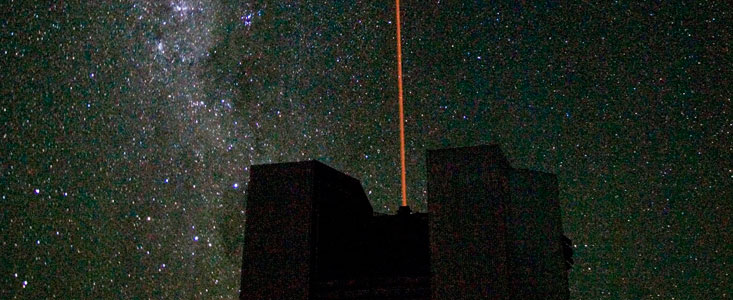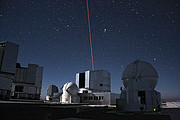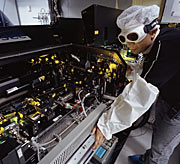Press Release
Man-made Star Shines in the Southern Sky
First Light for the VLT Laser Guide Star Facility
23 February 2006
Scientists celebrate another major milestone at Cerro Paranal in Chile, home of ESO's Very Large Telescope array. Thanks to their dedicated efforts, they were able to create the first artificial star in the Southern Hemisphere, allowing astronomers to study the Universe in the finest detail. This artificial laser guide star makes it possible to apply adaptive optics systems, that counteract the blurring effect of the atmosphere, almost anywhere in the sky.
On 28 January 2006, at 23:07 local time, a laser beam of several watts was launched from Yepun, the fourth 8.2m Unit Telescope of the Very Large Telescope, producing an artificial star, 90 km up in the atmosphere. Despite this star being about 20 times fainter than the faintest star that can be seen with the unaided eye, it is bright enough for the adaptive optics to measure and correct the atmosphere's blurring effect. The event was greeted with much enthusiasm and happiness by the people in the control room of one of the most advanced astronomical facilities in the world.
It was the culmination of five years of collaborative work by a team of scientists and engineers from ESO and the Max Planck Institutes for Extraterrestrial Physics in Garching and for Astronomy in Heidelberg, Germany.
After more than one month of integration on site with the invaluable support of the Paranal Observatory staff, the VLT Laser Guide Star Facility saw First Light and propagated into the sky a 50cm wide, vivid, beautifully yellow beam.
"This event tonight marks the beginning of the Laser Guide Star Adaptive Optics era for ESO's present and future telescopes", said Domenico Bonaccini Calia, Head of the Laser Guide Star group at ESO and LGSF Project Manager.
Normally, the achievable image sharpness of a ground-based telescope is limited by the effect of atmospheric turbulence. This drawback can be surmounted with adaptive optics, allowing the telescope to produce images that are as sharp as if taken from space. This means that finer details in astronomical objects can be studied, and also that fainter objects can be observed.
In order to work, adaptive optics needs a nearby reference star that has to be relatively bright, thereby limiting the area of the sky that can be surveyed. To overcome this limitation, astronomers use a powerful laser that creates an artificial star, where and when they need it.
The laser beam, shining at a well-defined wavelength, makes the layer of sodium atoms that is present in Earth's atmosphere at an altitude of 90 kilometres glow. The laser is hosted in a dedicated laboratory under the platform of Yepun. A custom-made fibre carries the high power laser to the launch telescope situated on top of the large Unit Telescope.
An intense and exhilarating twelve days of tests followed the First Light of the Laser Guide Star (LGS), during which the LGS was used to improve the resolution of astronomical images obtained with the two adaptive optics instruments in use on Yepun: the NAOS-CONICA imager and the SINFONI spectrograph.
In the early hours of 9 February, the LGS could be used together with the SINFONI instrument, while in the early morning of 10 February, it was with the NAOS-CONICA system.
"To have succeeded in such a short time is an outstanding feat and is a tribute to all those who have together worked so hard over the last few years," said Richard Davies, project manager for the laser source development at the Max Planck Institute for Extraterrestrial Physics.
A second phase of commissioning will take place in the spring with the aim of optimizing the operations and refining the performances before the instrument is made available to the astronomers, later this year. The experience gained with this Laser Guide Star is also a key milestone in the design of the next generation of Extremely Large Telescope in the 30 to 60 metre range that is now being studied by ESO together with the European astronomical community.
High resolution images and their captions are available on this page. This press release is also accompanied by Broadcast quality material.
Notes
The Laser Guide Star Facility is a collaborative project between ESO, the Max Planck Institute for Extraterrestrial Physics in Garching, Germany (MPE) and the Max Planck Institut for Astronomy in Heidelberg, Germany (MPIA). The team members are D. Bonaccini Calia, W. Hackenberg, M. Cullum, M. Dimmler, I. Guidolin, C. Araujo, E. Allaert, D. Popovic, M. Comin, M. Quattri, E. Brunetto, F. Koch, A. Silber, J-L. Alvarez, M. Tapia, E. Bendek, J. Quentin, G. Fischer, M. Tarenghi, G.Monnet, and R.Gilmozzi (ESO), R. Davies, S. Rabien, T. Ott, R. Genzel, S.Kellner, S. Huber, W. Zaglauer, A. Goldbrunner, and J. Li (MPE), and S. Hippler, U. Neumann, D. Butler, R.-R. Rohloff, and B.Grimm (MPIA). Members of ESO's Adaptive Optics team also participated to First Light: M. Kasper, S. Stroebele, E. Fedrigo, R. Donaldson, S. Oberti, and C. Soenke.
This press release is issued in coordination between ESO and the Max Planck Society. A German version is available at http://www.mpg.de/bilderBerichteDokumente/dokumentation/pressemitteilungen/2006/
Contacts
Domenico Bonaccini Calia
ESO
Garching, Germany
Tel: +49 89 3200 6567
Cell: +49 (0) 174 5246 013
Email: Domenico.Bonaccini@eso.org
Richard Davies
Max Planck Institute for Extraterrestrial Physics
Garching, Germany
Tel: +49 89 30000 3298
Email: davies@mpe.mpg.de
Stefan Hippler
Max Planck Institute for Astronomy
Heidelberg, Germany
Tel: +49 6221 528 265
Email: hippler@mpia.de
About the Release
| Release No.: | eso0607 |
| Legacy ID: | PR 07/06 |
| Name: | Laser Guide Star, Very Large Telescope |
| Type: | Solar System : Sky Phenomenon : Night Sky Unspecified : Technology : Observatory : Telescope |
| Facility: | Very Large Telescope |
| Instruments: | SINFONI |
Our use of Cookies
We use cookies that are essential for accessing our websites and using our services. We also use cookies to analyse, measure and improve our websites’ performance, to enable content sharing via social media and to display media content hosted on third-party platforms.
ESO Cookies Policy
The European Organisation for Astronomical Research in the Southern Hemisphere (ESO) is the pre-eminent intergovernmental science and technology organisation in astronomy. It carries out an ambitious programme focused on the design, construction and operation of powerful ground-based observing facilities for astronomy.
This Cookies Policy is intended to provide clarity by outlining the cookies used on the ESO public websites, their functions, the options you have for controlling them, and the ways you can contact us for additional details.
What are cookies?
Cookies are small pieces of data stored on your device by websites you visit. They serve various purposes, such as remembering login credentials and preferences and enhance your browsing experience.
Categories of cookies we use
Essential cookies (always active): These cookies are strictly necessary for the proper functioning of our website. Without these cookies, the website cannot operate correctly, and certain services, such as logging in or accessing secure areas, may not be available; because they are essential for the website’s operation, they cannot be disabled.
Functional Cookies: These cookies enhance your browsing experience by enabling additional features and personalization, such as remembering your preferences and settings. While not strictly necessary for the website to function, they improve usability and convenience; these cookies are only placed if you provide your consent.
Analytics cookies: These cookies collect information about how visitors interact with our website, such as which pages are visited most often and how users navigate the site. This data helps us improve website performance, optimize content, and enhance the user experience; these cookies are only placed if you provide your consent. We use the following analytics cookies.
Matomo Cookies:
This website uses Matomo (formerly Piwik), an open source software which enables the statistical analysis of website visits. Matomo uses cookies (text files) which are saved on your computer and which allow us to analyze how you use our website. The website user information generated by the cookies will only be saved on the servers of our IT Department. We use this information to analyze www.eso.org visits and to prepare reports on website activities. These data will not be disclosed to third parties.
On behalf of ESO, Matomo will use this information for the purpose of evaluating your use of the website, compiling reports on website activity and providing other services relating to website activity and internet usage.
Matomo cookies settings:
Additional Third-party cookies on ESO websites: some of our pages display content from external providers, e.g. YouTube.
Such third-party services are outside of ESO control and may, at any time, change their terms of service, use of cookies, etc.
YouTube: Some videos on the ESO website are embedded from ESO’s official YouTube channel. We have enabled YouTube’s privacy-enhanced mode, meaning that no cookies are set unless the user actively clicks on the video to play it. Additionally, in this mode, YouTube does not store any personally identifiable cookie data for embedded video playbacks. For more details, please refer to YouTube’s embedding videos information page.
Cookies can also be classified based on the following elements.
Regarding the domain, there are:
- First-party cookies, set by the website you are currently visiting. They are stored by the same domain that you are browsing and are used to enhance your experience on that site;
- Third-party cookies, set by a domain other than the one you are currently visiting.
As for their duration, cookies can be:
- Browser-session cookies, which are deleted when the user closes the browser;
- Stored cookies, which stay on the user's device for a predetermined period of time.
How to manage cookies
Cookie settings: You can modify your cookie choices for the ESO webpages at any time by clicking on the link Cookie settings at the bottom of any page.
In your browser: If you wish to delete cookies or instruct your browser to delete or block cookies by default, please visit the help pages of your browser:
Please be aware that if you delete or decline cookies, certain functionalities of our website may be not be available and your browsing experience may be affected.
You can set most browsers to prevent any cookies being placed on your device, but you may then have to manually adjust some preferences every time you visit a site/page. And some services and functionalities may not work properly at all (e.g. profile logging-in, shop check out).
Updates to the ESO Cookies Policy
The ESO Cookies Policy may be subject to future updates, which will be made available on this page.
Additional information
For any queries related to cookies, please contact: pdprATesoDOTorg.
As ESO public webpages are managed by our Department of Communication, your questions will be dealt with the support of the said Department.




